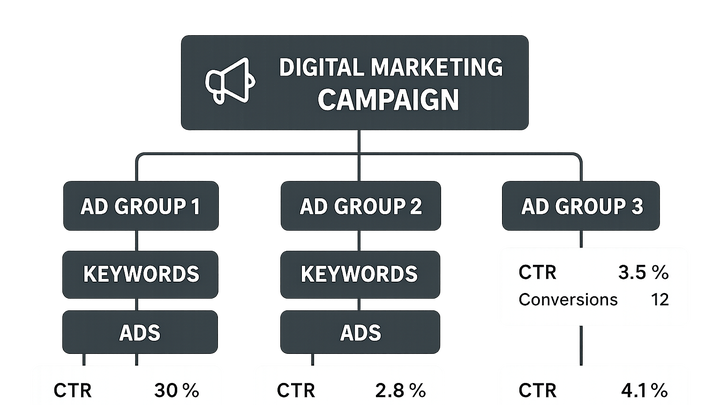Published on 2025-06-29T19:12:38Z
What is an Ad Group? Examples in Campaign Tracking & Analytics
An Ad Group is a modular component within a digital advertising campaign that groups related ads and keywords under a unified theme or targeting criteria. It enables marketers to organize ads based on demographics, interests, or product lines, facilitating precise budget allocation and optimization. By segmenting ads into ad groups, you can tailor messaging for different audience segments, test variations, and measure performance at a granular level. Within platforms like Google Ads or Facebook Ads Manager, ad groups sit between the campaign and ad levels, acting as the bridge between high-level objectives and individual creative assets. When integrated with analytics tools—such as Plainsignal for cookie-free tracking or UTM Guru for UTM parameter management—ad groups provide clear insights into which segments drive the most engagement, clicks, and conversions. This structured approach to ad management improves relevance, boosts ROI, and simplifies the process of A/B testing across multiple audience segments.
Ad group
Groups related ads and keywords within a campaign to enable targeted budget allocation, testing, and detailed performance tracking.
Definition and Importance of Ad Groups
Ad Groups serve as the second layer in the campaign hierarchy, providing structure to your advertising efforts. They enable precision targeting, budget control, and performance measurement at the segment level. By grouping ads around common themes—such as product categories or audience demographics—you can deliver more relevant messaging and streamline optimization. Ad groups also facilitate A/B testing of creatives and bidding strategies, making it easier to identify which combinations perform best. Their strategic use is essential for maximizing ROI and scaling campaigns effectively.
-
Logical organization within campaigns
Ad Groups cluster related ads and keywords under a single umbrella, reflecting a coherent theme or goal. This organization makes campaign management more intuitive and scalable.
- Hierarchical structure:
Ad Groups sit between the Campaign and Ad levels, allowing a clear breakdown of objectives and assets.
- Thematic grouping:
Grouping by shared themes (e.g., product lines, offers) ensures consistent messaging and easier analysis.
- Hierarchical structure:
-
Targeting and budget allocation
By assigning specific budgets and targeting settings to each ad group, marketers can optimize spend according to audience segments or keyword performance.
- Audience segmentation:
Define distinct audience segments within each ad group to tailor creatives and offers.
- Budget control:
Allocate budgets at the ad group level to prioritize high-value segments and manage spend caps.
- Audience segmentation:
Setting Up Ad Groups
Creating effective Ad Groups involves thoughtful naming, precise targeting, and strategic budget planning. Proper setup at this stage lays the groundwork for accurate tracking and optimization.
-
Naming conventions
Use consistent, descriptive naming to easily identify the purpose and scope of each ad group.
- Descriptive names:
Include product or theme keywords to quickly recognize ad group focus.
- Date and platform tags:
Add launch dates or platform abbreviations (e.g., FB, GAds) for context.
- Descriptive names:
-
Defining keywords and audiences
Select keywords and audience segments that align with the ad group’s theme to ensure relevant traffic.
- Keyword themes:
Group keywords that share intent or product relation to streamline bids and ads.
- Audience segments:
Target specific demographics or interests to enhance ad relevance and engagement.
- Keyword themes:
-
Budget and bidding strategies
Determine budgets and bidding tactics at the ad group level based on performance goals and expected ROI.
- Daily vs. lifetime budget:
Choose budget types that align with campaign duration and pacing needs.
- Bid adjustments:
Apply device, location, or time-based bid modifiers within each ad group.
- Daily vs. lifetime budget:
Integrating UTM Parameters
UTM parameters help attribute ad group-driven traffic in analytics platforms. Using tools like UTM Guru simplifies URL tagging and ensures consistency across campaigns.
-
Using utm guru for link generation
UTM Guru allows you to build, generate, and store UTM-tagged URLs for each ad group. Its Chrome extension integrates directly into your workflow.
Example UTM-tagged link:
https://example.com/?utm_source=google&utm_medium=cpc&utm_campaign=summer_sale&utm_adgroup=shoes&utm_content=ad_variant1- Building utm urls:
Use the UTM builder to set utm_source, utm_medium, utm_campaign, and utm_adgroup for precise attribution.
- Managing saved templates:
Save common parameter sets for future use and maintain naming consistency.
- Building utm urls:
-
Best practices for utm naming
Consistent parameter naming prevents data fragmentation in analytics.
- Consistent case:
Use lowercase letters for all parameters to avoid duplicates.
- Hyphens over spaces:
Replace spaces with hyphens or underscores for URL compatibility.
- Consistent case:
Tracking and Analyzing Ad Group Performance
Monitoring ad group metrics allows you to optimize campaigns in real time. Platforms like PlainSignal provide cookie-free analytics, capturing key performance indicators such as clicks, conversions, and revenue by ad group.
-
Implementing plainsignal script
Embed the PlainSignal script on your website and pass ad group context via data attributes.
- Script installation:
Add the following code to your site’s <head>:
<link rel="preconnect" href="//eu.plainsignal.com/" crossorigin /> <script defer data-do="yourwebsitedomain.com" data-id="0GQV1xmtzQQ" data-api="//eu.plainsignal.com" data-adgroup="summer_sale_shoes" src="//cdn.plainsignal.com/plainsignal-min.js"></script> - Data attribute configuration:
Use the
data-adgroupattribute to send the ad group identifier for accurate segmentation in reports.
- Script installation:
-
Analyzing key metrics
Review ad group performance in analytics dashboards, focusing on metrics that align with your objectives.
- Click-through rate (ctr):
Measure the percentage of ad views that resulted in clicks to gauge engagement.
- Conversion rate:
Track how many clicks led to desired actions to evaluate ad group effectiveness.
- Cost per acquisition (cpa):
Calculate spend per conversion to assess profitability at the ad group level.
- Click-through rate (ctr):
